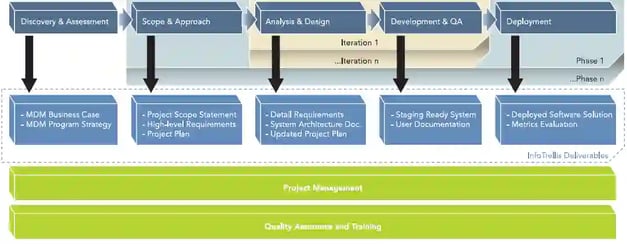Table of Content
TABLE OF CONTENTS

Every project comes with its own set of challenges and are no different. At InfoTrellis, we have built an effective methodology for Project Management, through years of experience in managing MDM projects. We like to call it as “InfoTrellis Smart MDM Methodology”.

The InfoTrellis Smart MDM Methodology is:
- A common sense based approach
- Constructed uniquely to meet challenges in MDM Projects
- Applies principles of RUP, Waterfall, and Agile project management models
It is an iterative delivery methodology that is designed to link business value and strategy into tactical, quick, and logically sequenced deliverables.
As you can see in the figure above, there are five stages to this methodology. They are:
- Discovery and Assessment
- Scope and Approach
- Analysis and Design
- Development and QA
- Deployment
I am going to group them into three master groups and discuss about each of these groups and challenges arising within them.
The Preparation
As the heading suggests, this section talks about the initial preparations the team has to do before starting an MDM implementation. The stages “Discovery Assessment and Scope Approach” are part of the preparatory steps one has to take.
Discovery Assessment
Our “Discovery” of the client’s MDM needs does not always start at the same point. These are the possible starting points:
- Client only has a business issue and is looking for a solution within the available tools in the organization
- Client has a business issue, realizes that the issue cannot be resolved with the available tools in the organization and willing to explore further
- Client has a business problem, knows that MDM is a solution but not sure about the next steps
-
Client has a road map, high level MDM architecture in place, and wants a validation of architecture and further collaboration during implementation
We take different approaches to each of these scenarios. Our objective in each case would be to help the client identify the right solution. As part of this phase, we come up with:
A clear business case:
- The true nature of the issue is not always clear at the beginning due to various environmental factors in an organization. Through constant inquiries, we identify all the issues faced, categorize them, prioritize them, and see if MDM is the right solution. At the end of our inquiries, if the discovery is that the client does not need an MDM solution, it is our duty to inform this to the client as well.
- Once the client decides on implementing an MDM solution, we continue our discovery by understanding the client’s business goals, current systems in place, and overall data vision of the organization.
- A strong business case for MDM is built with this understanding, and we help the primary sponsors of the project in selling the MDM vision to rest of the sponsors and stakeholders.
Program Roadmap:
- As part of the roadmap, we identify key master data entities (Customer, Product, Supplier, Account and so on), identify the different sources to be integrated, decide on features of MDM to be implemented, and prioritize each one of them
- A comprehensive data quality assessment is also done in order to plan for quality fixes well in time for requirements. In the next section below titled “Source Data Quality”, I have elaborated on the ways to do data quality analysis
- A phased approach to a multi-year roadmap is taken targeting key business deliveries at the end of each phase
- For a long term MDM investment, it is important to build the entire vision and roadmap at the beginning. This would help us anticipate and plan upcoming changes in the client’s technology and business landscape and phase our implementation accordingly
- Once the roadmap is in place, the implementation should be in baby steps such that the sponsors start seeing tangible benefits of the implementation as early as possible through small victories that cumulatively meets the MDM vision over the years
Source Data Quality
Poor Data Quality causes significant delay in MDM implementation plans. We get hit during the requirements / data mapping phase and also during the actual deployment. So, it is very important that a thorough Data Quality analysis using optimal tools is done even before we sit for requirements elicitation.
If possible, it would be best to analyze and identify data quality issues across all the sources that will be integrated before the actual implementation starts. If this is not possible due to various reasons, we should at least identify the first set of sources that will be integrated, and identify and fix quality issues within them. This will solve two things:
- We will be ready for the first phase and when we sit for data mapping, there will be sufficient clarity and minimal rework
- Once we get a grip on quality of data, along with what will be accepted by MDM, a parallel team can start working on analyzing the remaining source systems, ready in time for subsequent phases
There are also cases when we are brought in to make an assessment of an existing MDM implementation. For such clients, we don’t have to build their MDM roadmap or vision from the beginning, but based on what we see as the state of their MDM implementation, we help them re-align their vision and build a program roadmap from that point. Our rigorous approach in coming up with the re-aligned vision and roadmap is the same as the one we employ for a new implementation.
Scope Approach
As part of discovery, I mentioned having a long term vision. It is not only important to have a clear roadmap; having a strong, structured implementation plan is even more important.
The approach to an MDM implementation should cover the following:
- Determine priority of each of the master entities in the organization, and decide on which entity to implement first
- Identify source systems, analyze them, and come up with an integration plan of source systems
- As applicable, plan for building all necessary support architecture to handle real-time, near real-time and batch load data. For clients that already have these in place, evaluate and ensure readiness for MDM implementation
- In alignment with the client business and IT teams, come up with tangible deliverables for each phase that business can use, or see value in
- Come up with high level requirements document that forms the basis of detailed functional requirements and data mapping that should be created in subsequent phases
With the above details, a detailed Project Scope document that spills out all the phases of the project, and deliverables across each phase is created. A high-level project plan that tracks timelines and milestones is also created along with the scope document.
The Non-iterative preparation:
So far, we have seen the initial preparatory tasks to be done before starting the next stages of MDM implementation. Through our experience, we have learned that the preparatory tasks are best done in a sequential or “waterfall” way, with sufficient time and expertise loaded at the top.
Benefits of an MDM implementation are realized over many years, and a wrong step during the preparatory phase would lead to unrealized vision, and heavy losses towards the end. So, we provide sufficient time for Discovery, Assessment, Scoping and Approach. Once the preparations are in place, we can start following an iterative / agile based management for a much faster implementation.
In Part II of this series, I will cover rest of the stages in our Methodology when I talk about “Implementation” and “Deployment”.
-2.jpg?width=240&height=83&name=Menu-Banner%20(5)-2.jpg)
.jpg?width=240&height=83&name=Menu-Banner%20(8).jpg)


